|
Leif Elggren and Kent Tankred have worked in the arts for over 20 years. In 1988 they formed the duo, The Sons of God (Guds Söner), a constellation which moves freely between performance, music and the visual arts, and whose productions often reach a point where traditional aesthetic boundaries, limitations and concepts are eliminated. The Sons of God observe and document, experiment and ask questions, build up and tear down. They leave it to the viewer to take what he/she wants or simply leave. | 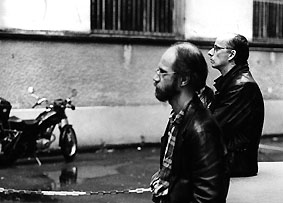 Photo: Dinka Pignon |
|
An information flyer about the Sons of God describes their art thus:
"The Sons of God work in the borderland between performance, installation and music; everything contributes to the whole and provides the basic structure for that inquisitive and expansive spirit which is apparent in the Sons of God´s working method. Sound objects, pre-recorded compositions, physically demanding movements, the voice, the staged meetings and conditions, the objects: all of this constitutes the foundation for an attempt to gain access to those hard to those rare moments when daily life merges with the heroic nature of the inner self." Expeditions in Performance Art Leif Elggren and Kent Tankred have worked together since 1985. Elggren´s artistic career began with drawing and graphic arts in the mid-seventies. His first publication came in 1976 with the book "Nervsystem" (Nervous System) which consisted of drawings in combination with poems by the Swedish poet Eric Fylkeson. At the end of the 1970s, he began working with performance art. At this time he also meets Thomas Liljenberg with whom he initiates the work-in-progress Firework project. He also starts working with Carl-Michael von Hausswolff. After working together in an international performance festival in Stockholm, Elggren and von Hausswolff create the now-classic performance piece "Vavd/Trans/Aktion" (1981). CM von Hausswolff lies in an aquarium filled with cold water and Leif Elggren drags himself along a line across the floor, back and forth 63 times, writing a word on the blackboard each time he reaches the wall. Kent Tankred is sitting in the audience fascinated, he has never seen anything like it before. The same year, Leif Elggren and Thomas Liljenberg perform another piece "Firework Fas 1:6". In this piece, the two, along with Per Jonsson, Iréne Hultman, CM von Hausswolff and Inger Arvidsson are together in a room where they move slowly, but so slowly that someone sitting in the audience during the entire performance can hardly notice the difference. Katrin von Rettig is also in the room where she performs certain acts with water buckets, among other things. In a later performance that year, called "10 dagar - En expedition" (10 days‹An Expedition), Leif Elggren locks himself in a room and viewers can only see him through a hole in the wall. With only the most essential possessions with him, Elggren lives in the room for 10 days of "fasting, silence, vigil, privation, seclusion, tranquillity, perseverance, purification, concentration, construction and artistic consistency". Every morning he puts on black lipstick and kisses a slip of paper until it becomes totally black. "UGN" In 1985, Leif Elggren begins to work with Kent Tankred, and together with Per Jonsson, they perform the piece "UGN - ett arbetspass" (OVEN - a work shift), which includes an old military kitchen and 27 white "angels". Exactly when Kent´s artistic career began is uncertain. He had been actively painting and doing experimental music for a number of years within the auspices of Fylkingen, Stockholm´s illustrious venue for experimental music and mixed media art. He was also the originator of the Konkresizer, which has become somewhat of a concept at Fylkingen. The Konkresizer is an analogue keyboard instrument which differs from the synthesiser in that it allows you to see how sounds come about and what makes the sounds. The following year, the Sons of God release their first record‹a sound documentation of "UGN" - on CM von Hausswolff´s label Radium based in Gothenburg. | |
| In 1988, Leif and Kent christen their duo the Sons of God. Since then, the two have presented nearly 30 performance pieces and much more. Among their performances, "Mission", "Jag.... talar" (I....speak), and "Svisch...och så går det en tid" should be mentioned. In "Mission", which is also on CD and video, the Sons of God drag a large object, one so heavy that it´s almost impossible to move, across the stage for four hours. Later in the piece, Kent collapses whereupon Leif drags him across the floor into a beam of light which falls from the ceiling, like a pietá. | 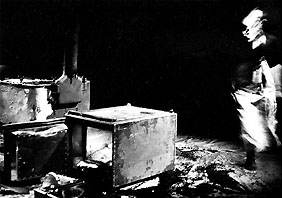 UGN - Photo: Åke Wessman |
|
Their Own Kingdom On March 14, 1992 a new realm is created by Leif Elggren and CM von Hausswolff, KREV. On that day, they annexed and occupied "All border frontier areas between all countries on earth, and all areas (up to a width of 10 nautical miles) existing outside all countries´ territorial waters. We designate these territories our physical territory. Mental and perceptive territories such as: the Hypnagogue State (civil), the Escapistic Territory (civil) and the Virtual Room (digital)". These territories constitute Elgaland-Vargaland where Leif I and Michael I are kings. The kingdoms establish embassies in art galleries all over the world, there are at present embassies in 14 countries. Recently a national anthem was chosen for Elgaland-Vargaland. The melody is an old Swedish march, but the tempo is considerably slower in this version. All the citizens of Elgaland-Vargaland have the right to compose their own version of the national anthem, which is now out on CD. Some of these versions will also be released, among others one done by John Duncan. Kent Tankred was nominated Chairman of the Board at Fylkingen in 1993 and has remained so until this year 1997, which will be his last. That same year, Leif Elggren and Thomas Liljenberg launch a project called "Experiment with Dreams" where they write letters to different famous celebrities and powerful people. For example, they accuse William Gibson of having stolen the whole novel "Neuromancer" from a dream Leif and Thomas had several decades ago, and demand royalties for the book sales. They also write to Cindy Crawford and tell her that they made her pregnant a number of years ago and that the child is in Sweden and would really like to see his mother. | |
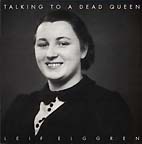 | Elggren releases the CD "Talking to a Dead Queen" in 1996. Here he makes use of several copper pipes which emit low frequency sound. By positioning himself between the pipes and the speaker, he can regulate the course of the sound. The idea comes from Napoleon who wrote in his diary that he had several visions of copper pipes hanging over his bed which emitted a humming sound. When he heard that sound he believed he was in contact with people from the past like Caesar and Charlemagne who gave him advise on military operations. On this CD, Elggren tries to contact Queen Kristina as well as his aunt who was being buried the same day he was making the recording. |
|
Later that year, the Sons of God start their own record company, Firework Edition Records, which has since produced a number of sound documentations of their performances. The name Firework Edition had previously been used to produce cassettes and books. Physical Preparation The production of the Sons of God is characterised by certain themes and perspectives, among them are food, religion, work and militarism. What is the significance of these themes? Leif: With the help of these themes we try to find our way to a situation or condition which can be likened to a miracle. We are looking for a point where all aspects we work with converge and something extraordinary happens. Kent: We bring together these aspects of basic human behaviour until we get to a point where everything transcends into something different. Leif: We often work with physicality in order to put ourselves in a position where it is possible to reach this point. Our preparations are perhaps not discernible to the audience; we might have been up all night or physically exerted ourselves through manual labour. This makes it possible to relate to our artistic work and open up situations we otherwise could not gain access to. This way, we also avoid given aesthetic gestures which could lead us onto a predetermined course of action. Sometimes we have had things like stones in our shoes to divert our attention and prevent us from creating a conscious aesthetic. This way, things can take place outside of our conscious control and we will be more "authentic". Kent: We try to be authentic, or rather, we try to be what we do and not simply act things out it. When we create a space, it is not about a kind of aestheticism. We create a devotional room which we invite the audience to enter. Divine Humanity In many of the productions of the Sons of God, you seem to be more interested in investigating and describing different phenomena and objects than creating art for aesthetic purposes. Kent: We did a performance where we tried to make a carpet fly. We failed, which naturally is totally beside the point. There were people who thought it was a bad performance since we failed. But what was the point of the performance? We tried to fly using the carpet and if it was successful or not is totally uninteresting. What is interesting is to arrange new situations. Leif: What we did was to stage an attempt to fly, whether it was aesthetic or not is beside the point. In your art, you often work with basic elements as a means of gaining access to the more complex truths. Large and small, high and low become blurred. This is evident in your name, the Sons of God, for example. Leif: Through the name we categorise ourselves as something very select, as if we were two Jesus Christs. On the face of it, we create an image of strong hubris, but when you come to think of it, we are just saying that we are human beings, but with all the human worth every individual is entitled to. Kent: Through the name, we invite all people to become just as exalted as we are. Divinity is thus nothing we lay exclusive claim to. The Course of Time On stage, the Sons of God make use of different objects to reach their goals. More often than not, they are very simple objects like rakes, chairs and girders. What is the role of these objects in your performances and how do you relate to them? | |
|
Leif: We use the objects to express something that they could not express in another context. Sound is important in our performances and often it is produced by the objects on stage. Even if we are not subordinate to the objects, we have a respectful relation to them. There are no limits. Like the objects, we have merged with the overall situation. Kent: We try to create an imagery on stage where the objects acquire a special meaning through their spatial relations. We often use neutral clothes, like work aprons, which are in harmony with whatever else is on stage. We are an integral part of the whole and we wouldn´t distinguish ourselves through clothes which would indicate that we are superior to the objects. We may be the objects. | 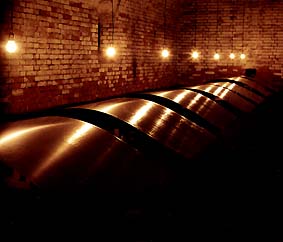 Mottagning - Karlsborgs fästning - Photo: Torbjörn Josefsson |
|
The performances by the Sons of God are often very long. They can take many hours or until the audience has grown tired and left. After a while, the viewer can easily get a feeling of timelessness. What is the significance of time in your performances? Kent: Time is only significant to the extent that we need a minimum amount of it. Nothing should happen too fast. Leif: When that minimum amount of time is up, the concept of time dissolves and becomes unimportant. Sometimes we accentuate the significance of timelessness by starting a performance before the audience arrives. We could have been doing this since the beginning of time. Often we continue until the audience has grown tired and left. Thus, the audience often sees only a fraction of an endless series. When we drive chairs we usually disappear from the stage but continue to drag the chairs so that the audience continues to hear us from another room or out on the street. Solemnity and Comedy In the often recurring feature, "Guds Söner kör stolar" (The Sons of God Drive Chairs), the duo stacks school chairs and drags, bounces and drives them over the floor in order to produce a squeaking, grating sound‹this action can at first appear to be comical and absurd, almost ludicrous. At the same time, it can be experienced as something totally different and much more serious. Kent: We never do anything just for the fun of it. We are fundamentally totally serious, but then again, situations like when we drive chairs can be comical anyway. It started when we discovered the sound you could get out of chairs when you drag them along a surface. Our intentions are always serious. The funniest situations are when someone has completely serious intentions with what he or she does. Leif: We are basically enormously pretentious, but on the other hand, there is something liberating in this. When we use rakes it never becomes a comical situation because we are using the tools for what they were made for. When we drive chairs we feel a kind of lightness and freedom. This makes the situation seem more comical. People discover that "this is something you can do with a chair". It is more accessible than other things we do. Kings and Queens Royalty and the trappings of grandeur are recurrent themes in a number of productions by the Sons of God, above all in Elggren´s work with Elgaland-Vargaland. Where does this fascination with royalty come from? Leif: The King is always the highest being, the most desirable and enviable, the most unapproachably beloved. A kind of ideal. But the antithesis is also there: he is the one whose place you would like to take, the one you want to kill and dethrone. Royal symbolism is incredibly fundamental in our culture, very ancient, and although it may have been dormant for a time during the age of modernity, I discern the dawning of a resurgence. Take Sweden, for example when the King had his fiftieth birthday, the enormity of the homage and official rituals. Or when Prince Bertil died. It is almost ridiculous how people mourn this way for a person who has only been significant through his symbolism. On the whole, there is so much that a royal personage bears, so much that is projected onto him/her - people´s trust, their belief in the future and their own capabilities. A president does not have the same significance in matters like this. The King and Queen have, admittedly, become superficial objects for the tabloids and women´s magazines, but behind this facade, there is something more meaningful and serious. The King is a father figure and representative of each and every person. A piece of every person is invested in this figure, every person has automatically invested part of him or herself in him. Kent: It is also significant that the King is not chosen or re-elected like a president is. The King cannot be chosen and this is why he is almost like a Jesus figure. No Rebellion Against the Father The Sons of God make frequent use of history and historical symbols in their work. In much modern art there is an antagonism between Classicism and Modernism, but not for the Sons of God. Leif: The antagonism you refer to has to do with always reacting against something - an incessant continuing rebellion against the Father. You force yourself into opposition, and try to tarnish things, mess them up. We are not interested in doing this. Instead we want to present our work and carry on with our own task. But this doesn´t mean that we can´t object to certain things. We are trying to keep up a conversation with life and follow signs which can lead us in the right direction. Kent: We are not interested in doing something in opposition. We do what we do because there is something there which is powerful and has a positive value. Dead Music There are often stiff barriers between different types of experimental music. Genres which are musically quite close to each other can have totally different groups of listeners, a consequence of the music world´s unfortunate category and genre divisions. Nevertheless the Sons of God are a well-known name, both in contemporary art music circles and the more underground experimental music movement as well as in industrial music. Leif: We do not limit ourselves to one area, we move about in different circles. I think that a lot of people who work with art music, for example, move only in their own circles and socialise only with people who are doing the exact same things. They are afraid of losing prestige, so they close themselves off. A lot of the "Fine art" type music can really be stone-dead. It has lost all its original ambition, its sole task is to fulfil some kind of societal role, which is terribly predictable and sad. There is no life in it. A lot of rock music, for example, has a totally different kind of life in it. It conveys a totally different zest for life, or gives you another kind of kick. Kent: The group itself defines its own boundaries. Many gain a sense of identity by belonging to a certain group and therefore do not want to move outside of the group. This kind of thinking is not for us. What we think is interesting is to find different types of places, audiences and occasions. We are currently in contact with some priests about doing a performance at a church service. Coincidences lead us to these kinds of things. Every new event can involve finding something totally new that you didn´t know about before and whatever you call it is totally uninteresting. Electro-acoustic composers can be so fixated with how the space is during their performances, that no noise or humming sounds intrude. This makes their music almost impossible to play. Leif: Many electronic music composers are obsessed with meaningless details. "He is using this filter.", "...too much reverb", "Here, you can hear what programme he is using". And they dismiss music with these types of arguments. To a certain extent, there was a different spirit among the older generation of artists, like Sten Hanson for example. He always feels so vital and energetic. He can also move between different levels and would also fit well in other contexts. Art Not Culture The Sons of God also make use of different quotes in their work. "Fortplantningen - det enda sanna" (Reproduction - the only truth) Leif: The only thing we know is that we are born to this world and to the people around us and that is the only thing we can really relate to. Everything depends on the circumstances we are born to, what people we have around us and what environment we live in. Kent: "Reproduction" in art is a difficult subject. We once did a slide presentation with only pornographic photographs. This is taboo, forbidden territory in most of the art world. We are interested in treading on forbidden territory. "The Struggle Against Sleep and Indolence" Leif: Man is always struggling against an innate inertia and hardship. There is so much that can stop you, so much that makes it easy to give in. Dose off and let time go by. We work against this. We were born to this life and the only thing we know about it is that we are going to die. We are driven by the feeling of completing our mission, we want to finish our task. There is the urge, the desire to see and understand. Kent: The choice is between laziness versus something you recognise is going to be difficult to accomplish. What´s important is to complete the mission and not to compromise one's ambitions. We always carry out what we have planned, despite the problems - it is a kind of foundation for everything we do. What's important for us is how to execute and develop our artistic work. Leif: Art is extra-cultural. Art is something totally different from culture. Culture is what binds us together in this society. Art is disengaged from this and functions as a kind of nourishment for people to find something in their lives. Both for the practitioner and the viewer. Art is a tool with which to achieve an individual truth, it tells us how we must live our lives. Art should be congruous with the task one is born to. "The Sons of God are in the service of civil defence and aim to infuse energy and courage." | |
|
Kent: There are moments in everyday life when one can experience something heroic. Every person can become a hero in his or her life. Leif: Every individual has a purpose in life. Our piece "Mission" is an allusion to this. It emphasises our mission and our feelings when confronted by it. We would like to show that something can radiate out from us, and that our actions make it possible to influence our surroundings. And if we can influence other people to think about the mission every person has, then we have accomplished something. That is our mission. | 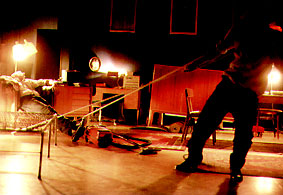 GS möblerar om - Photo: Fabio Galli |
|
The vigorous explorations undertaken by the Sons of God - of concepts like art, humanity and nature - continue to take on different expressions in their creative work, but not even they know exactly what developments lie in the future. The production of the Sons of God shows that artistic work can answer the most universal as well as the most intimate questions, and that the concept of art can easily become limiting or insufficient to describe such a broad body of work as theirs. In the Sons of God´s work, their exploration of both the spiritual and the material is juxtaposed to aesthetics´ inquiry of the individual, sensitive image of the beautiful and the ugly, the good and the bad, the true and the false, all shrouded in a mythological glow. In their work, aspects like the present, the future and the past, subject and object, mind and matter become blurred and produce a higher, almost spiritual, whole. In many ways, the art of the Sons of God is unlike any other - although it is possible to understand in relation to several movements - it lives its own life, unconstrained by both contemporary currents and the almost inevitable demands of the past. The art of the Sons of God is universal in the sense that it is relevant to any number of unspecified times, places and phenomena and that it influences the viewer on many levels, both mental and physical. The Mission continues. Daniel Rosenhall (Translation, Swedish to English: Kristina Riegert.) | |